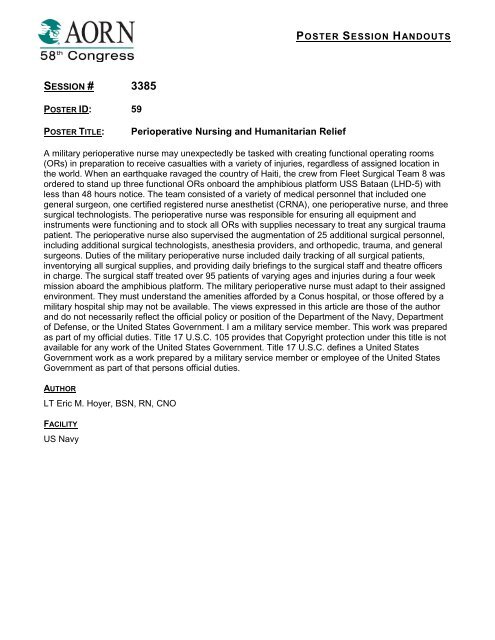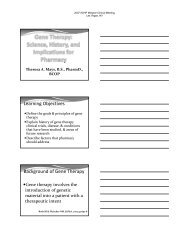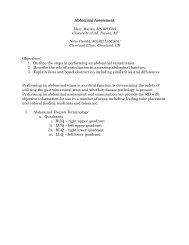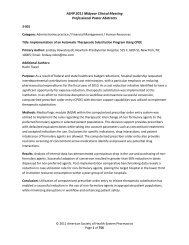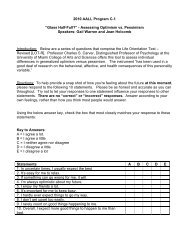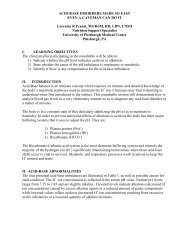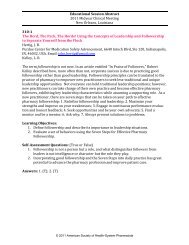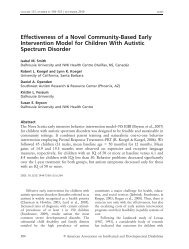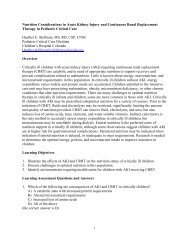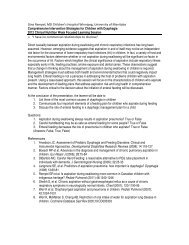Clinical Improvement/Innovation Poster Abstract Evaluation
Clinical Improvement/Innovation Poster Abstract Evaluation
Clinical Improvement/Innovation Poster Abstract Evaluation
You also want an ePaper? Increase the reach of your titles
YUMPU automatically turns print PDFs into web optimized ePapers that Google loves.
POSTER SESSION HANDOUTS<br />
SESSION # 3385<br />
POSTER ID: 59<br />
POSTER TITLE:<br />
Perioperative Nursing and Humanitarian Relief<br />
A military perioperative nurse may unexpectedly be tasked with creating functional operating rooms<br />
(ORs) in preparation to receive casualties with a variety of injuries, regardless of assigned location in<br />
the world. When an earthquake ravaged the country of Haiti, the crew from Fleet Surgical Team 8 was<br />
ordered to stand up three functional ORs onboard the amphibious platform USS Bataan (LHD-5) with<br />
less than 48 hours notice. The team consisted of a variety of medical personnel that included one<br />
general surgeon, one certified registered nurse anesthetist (CRNA), one perioperative nurse, and three<br />
surgical technologists. The perioperative nurse was responsible for ensuring all equipment and<br />
instruments were functioning and to stock all ORs with supplies necessary to treat any surgical trauma<br />
patient. The perioperative nurse also supervised the augmentation of 25 additional surgical personnel,<br />
including additional surgical technologists, anesthesia providers, and orthopedic, trauma, and general<br />
surgeons. Duties of the military perioperative nurse included daily tracking of all surgical patients,<br />
inventorying all surgical supplies, and providing daily briefings to the surgical staff and theatre officers<br />
in charge. The surgical staff treated over 95 patients of varying ages and injuries during a four week<br />
mission aboard the amphibious platform. The military perioperative nurse must adapt to their assigned<br />
environment. They must understand the amenities afforded by a Conus hospital, or those offered by a<br />
military hospital ship may not be available. The views expressed in this article are those of the author<br />
and do not necessarily reflect the official policy or position of the Department of the Navy, Department<br />
of Defense, or the United States Government. I am a military service member. This work was prepared<br />
as part of my official duties. Title 17 U.S.C. 105 provides that Copyright protection under this title is not<br />
available for any work of the United States Government. Title 17 U.S.C. defines a United States<br />
Government work as a work prepared by a military service member or employee of the United States<br />
Government as part of that persons official duties.<br />
AUTHOR<br />
LT Eric M. Hoyer, BSN, RN, CNO<br />
FACILITY<br />
US Navy
POSTER SESSION HANDOUTS<br />
SESSION # 3385<br />
POSTER ID: 60<br />
POSTER TITLE:<br />
Developing a Case Cart System in a Renovated Space<br />
At University Hospital St. Paul, a case cart system was not available due to space constraints. We<br />
perform approximately 150 cases each week and pulling cases takes valuable time away from the<br />
nursing staff that could best be applied to performing patient care activities. A vacated rehab area was<br />
located as available space and is now being renovated to include supply receiving, case cart pulling,<br />
and staging areas. This project requires the cooperation of the operating room (OR), facilities support,<br />
sterile processing, and supply chain management staff. Workflow and process changes are necessary<br />
to make the new system successful. The outcome will free up OR nursing staff to provide clinical<br />
patient care rather than pulling cases and checking case carts. The project impacts inventory, resource<br />
utilization, staffing, processes, and supply chain management. Current and future state workflows must<br />
be identified and developed to ensure that case carts are correctly picked, staged, stored, and in the<br />
correct location as needed for patient care. An added bonus is additional storage space for OR<br />
equipment once supplies are relocated in the case cart area. We are using a team approach to create a<br />
process that will provide a positive outcome for our patients, staff, and physicians.<br />
AUTHOR<br />
Renee D. Bailey, MS, RN, CNOR<br />
FACILITY<br />
University of Texas Southwestern Medical Center
POSTER SESSION HANDOUTS<br />
SESSION # 3385<br />
POSTER ID: 61<br />
POSTER TITLE:<br />
Evidence-Based Practice for Mechanical VTE Prophylaxis<br />
Purpose: Determine evidence-based practice for implementation of mechanical venous<br />
thromboembolic (VTE) prevention in the perioperative period based on a systematic literature review.<br />
Methodology: Systematic literature review of the Ovid database for all currently available years was<br />
conducted to answer the following questions. What evidence exists for optimal application time of<br />
intermittent pneumatic device (IPC) and compression stockings for perioperative prophylaxis? What<br />
evidence exists for addressing the benefit of using a combination of IPC and compression stockings?<br />
What evidence exists regarding efficacy of use of mechanical prophylaxis both perioperatively and<br />
postoperatively? What evidence exists regarding alternative configurations of mechanical prophylaxis<br />
for use on specialty operative tables?<br />
Results: Optimal application time was determined to be as soon as possible prior to the surgical<br />
procedure. In some instances, the application of device(s) may be as much as one-hour prior to<br />
transport to surgery. There is no consensus in the literature that the combination of compression<br />
stockings with IPC offers any additional benefit in preventing VTE. Fibrinolytic activity is increased by<br />
use of external compression and that the effect lasts up to three days postoperatively. No alternative<br />
configurations with significant supporting evidence were identified for use with specialty operative<br />
tables.<br />
Implications for Perioperative Nurses: Evidence suggests implementation of mechanical prophylaxis as<br />
early as possible in the perioperative period decreases occurrences of VTE for the surgical patient.<br />
Ambulatory patient prophylaxis should begin as soon as they are settled, and prior to transport to the<br />
operative suite. Prophylaxis should be maintained for all patients throughout the perioperative period.<br />
AUTHOR<br />
Brenda G. Larkin, MS, RN, CNOR, TNCC, APRN-BC; Matthew E. Beier, MS, RN, CNS-BC, CNOR;<br />
Cindy Lewis, RN; Kimberly M. Mitchell, BSN, RN, CNOR; and Kathryn H. Petrie, RN<br />
FACILITY<br />
Aurora West Allis Medical Center
POSTER SESSION HANDOUTS<br />
SESSION # 3385<br />
POSTER ID: 62<br />
POSTER TITLE:<br />
The Effectiveness of Evidence-Based Surgical Gloving<br />
Purpose: The purpose of this study is to investigate current additional surgical gloving protection aimed<br />
at preventing micro-perforations in surgical gloves.<br />
Methodology: 585 innermost pairs of surgical gloves were collected in an academic medical center in<br />
San Francisco. Gloves were subjected to a watertight test to reveal otherwise undetected microperforations.<br />
Additionally, 144 pairs of an orthopedic surgical teams triple gloving combinations that<br />
include cloth gloves, colored indicator gloves, special orthopedics gloves, and powered and nonpowered<br />
gloves were tested for micro-perforations.<br />
Results: 87% of surgical team members practice the double gloving, while 13% practice single gloving.<br />
The undetected micro-perforation rate in the innermost pairs of surgical gloves was 2% and 3%,<br />
respectively. It approximately four times lower than the reported rate in the literature, which was ranged<br />
from 8% to 50%. The undetected micro-perforation rate using triple gloving combinations that included<br />
special orthopedic gloves as innermost pairs was 0%.<br />
Perioperative Nursing Implications: Double gloving with either colored perforation indicator gloves or<br />
special orthopedics gloves is an inexpensive practice reducing the micro perforation rate in the<br />
innermost pair of surgical gloves. Results of this study may provide perioperative nurses a guide in their<br />
usage of surgical gloving protection while not yet establishing a standardized additional glove protection<br />
method. Limitation of this study was other possible contributing factors were not controlled, such as the<br />
seniority and subsequent experience of the glove wearers. Further study is needed to evaluate the<br />
relationship between clinically visible glove perforation and the occurrence of SSIs.<br />
AUTHOR<br />
Kyung Mi Kim, MS, RN<br />
FACILITY<br />
St. Mary's Medical Center
POSTER SESSION HANDOUTS<br />
SESSION # 3385<br />
POSTER ID: 63<br />
POSTER TITLE:<br />
Manifestations of Hypothermia During Anesthesia Recovery<br />
Hypothermia interferes with the biotransformation of drugs, increasing the duration of action of<br />
sedatives, hypnotics, and anesthetics, delaying recovery of consciousness, and that tremors may<br />
determine the increase in oxygen consumption and production of carbon dioxide. The aim of this study<br />
was to identify the signs of hypothermia in the anesthetic recovery room. The sample consisted of 30<br />
adult patients with body temperature at the entrance to the operating room (OR) between 36°C and<br />
37.2°C, elective surgery and general anesthesia. The results showed a predominance of females, aged<br />
between 28 and 38 years, with surgery for diagnostic hysteroscopy and endometrial biopsy. Regarding<br />
axillary temperature of the patient off the OR, the majority 22 (73.3%) maintained between 35.1°C and<br />
35.9°C, and seven (23.4%) with temperature below 35°C. Most patients 24 (80.0%) remained<br />
hypothermic during the first 30 minutes spent in the anesthetic recovery room, with axillary temperature<br />
between 35.1°C and 35.9°C. As to the manifestations of hypothermia, the average was 1.83 events per<br />
patient, and hypoxemia in 22 (73.3%), requiring oxygen to maintain oxygen saturation, tremors in 20<br />
(66.6%), pallor in eight (26.6%), and hypertension in five (16.6%). As for methods for treatment of<br />
hypothermia, 30 (100.0%) used a sheet and blanket policy. It was concluded that the patient develops<br />
hypothermia in the OR, staying in the anesthesia recovery room, with various manifestations, so it must<br />
be prevented in the OR to avoid complications.<br />
AUTHORS<br />
Ana Lucia De Mattia, PhD, RN; and Maria Helena Barbosa, PhD, RN<br />
FACILITY<br />
Minas Gerais Federal University School of Nursing, Brazil
POSTER SESSION HANDOUTS<br />
SESSION # 3385<br />
POSTER ID: 64<br />
POSTER TITLE:<br />
Lessons Learned During Implementation of a Perioperative<br />
Information System<br />
The National Institutes of Health, Department of Perioperative Medicine, implemented electronic<br />
documentation for statisical perioperative information in June 2006, and implemented nursing clinical<br />
documentation in July 2009, which interfaced with the clinical center's preexisting electronic medical<br />
records system.<br />
Purpose: The goal of this poster is to educate institutions regarding lessons learned from our<br />
implementation of a perioperative information system.<br />
Description of Events: Since Executive Order 13335 mandated electronic patient care records in 2004,<br />
hospitals have been charged to implement an electronic medical record system, including a<br />
perioperative information system. Paper charting is fast becoming obsolete. Advantages of an<br />
electronic medical record include readability, consistency in charting, accessibility to care provider,<br />
simplicity, increased speed in charting, ease of obtaining data, and increased patient protection from<br />
human errors.<br />
Perioperative Nursing Implications: Downtime processes and education to be used if system is not<br />
stable or is down. Delay in accessing patient information when interfaces not working. Charting is<br />
streamlined, easier, and saves time for perioperative nurses. Patient can receive more individualized<br />
attention from the perioperative nurse.<br />
Outcomes: Many lessons during this implementation project were learned. Institutional decisions are<br />
made for reasons which are not always shared with key players in the implementation. If any clinical<br />
staff will be involved with the implementation of the system, additional resources must be provided to<br />
assume clinical duties. The institution needs to have a financial plan for unplanned costs. If interfacing<br />
with an existing hospital information system, make sure information is compatible and fields match in<br />
both systems. A change or upgrade in any system or process may require modifications. The quick fix<br />
does not always work. A thorough change in management process needs to be in effect in order to<br />
ensure valid testing of system changes. In conclusion, while there are many advantages for utilizing a<br />
perioperative information system, it must be realized that such an implementation is a complex process<br />
and the specific needs of the institution adopting such a system should be carefully considered.<br />
AUTHORS<br />
Maureen George, BSN, MSEd, RN, CNOR, OCN; and Nova D. Little, MS, RN, CNOR<br />
FACILITY<br />
National Institutes of Health
POSTER SESSION HANDOUTS<br />
SESSION # 3385<br />
POSTER ID: 65<br />
POSTER TITLE:<br />
LVAD Technology at Northwestern Memorial Hospital<br />
LVAD technology provides definitive treatment of heart failure. The purpose of this abstract is to<br />
discuss the technologies used at Northwestern Memorial Hospital (NMH) for bridge to transplant<br />
patients.<br />
Description of Team: Departments of surgery, anesthesiology, cardiology, and nursing.<br />
Preparation and Planning: Patients who advance to or acutely develop Stage 4 heart failure based on<br />
ACC/AHA system are evaluated for cardiac transplant and/or long-term mechanical circulatory support.<br />
After appropriate medical and surgical workup and patient consent, surgery is scheduled for device<br />
implantation.<br />
Assessment: Northwestern Memorial Hospital embraces the work of nursing theorist Virginia<br />
Henderson. Henderson's work focused on patient-centered care and, as such, NMH nurses embody a<br />
Patient Centered Care Model. The perioperative course for management of end-stage heart failure<br />
patients includes well developed evidence based nursing practice.<br />
Implementation: Prevention of major adverse events postoperatively requires a coordinated team effort<br />
in the operating room. Extensive surgical dissection for creation of a pump pocket exposes the patient<br />
to increased risks for bleeding, hematomas, and driveline infections. Anticipating the needs of the team<br />
can significantly reduce the incidence of these events.<br />
Outcomes: During the perioperative course, competent nursing results in decreased procedure time,<br />
decreased need for transfusion, and ethical support for family and patient.<br />
Implications for Perioperative Nursing: Aging of the population in industrialized countries will lead to<br />
continuous increases in heart failure. Perioperative nurses will need knowledge of VAD technology to<br />
properly care for heart failure patients requiring mechanical circulatory support.<br />
NOTE: A product in this poster is being used for a purpose other than for which it was approved<br />
by the Food and Drug Administration (FDA).<br />
AUTHORS<br />
Maggie C. Oldham, MSN, RN, CNOR; Ella S. Echavez, RN, CNOR; and Margaret M. Simons, RN<br />
FACILITY<br />
Northwestern Memorial Hospital
POSTER SESSION HANDOUTS<br />
SESSION # 3385<br />
POSTER ID: 66<br />
POSTER TITLE:<br />
Chill Out<br />
Malignant Hyperthermia (MH) is a rare occurrence, but nursing and medical staff must recognize and<br />
initiate treatment of a MH crisis immediately. The need was identified to develop an ongoing learning<br />
opportunity and competency evaluation of critical skills needed in a MH crisis. Knowledge of the the<br />
recognized MH guidelines decreases the risks of MH mortality. The project goal was to provide and<br />
offer increased MH disease knowledge, practice-based learning, treatment modalities, and critical skill<br />
performance improvement. Utilizing a Medical Advanced Skill and Simulation Education Center, our<br />
team of a simulation nurse, hospital education coordinator, and periopative unit educators established a<br />
MH learning event. We staged a simulation scenario and training activity for perioperative staff and<br />
physicans. Our MH policy was revised and our cart contents reorganized to reflect current AORN and<br />
Malignant Hyperthermia Association of the United States (MHAUS) guidelines. We developed and<br />
assigned computer based self learning modules for nursing staff to complete prior to the simulation lab<br />
experience. Medical and nursing staff participated in the activity. Participants were able to demonstrate<br />
recognition and treatment of MH, knowledge of proper Dantrolene Sodium mixing/usage, and<br />
management of MH susceptibleclients. Teamwork, communication skills, professionalism, knowledge of<br />
the disease process, and post procedural care were also demonstrated and discussed. MH training in<br />
the simulation lab is now required for new staff during orientation and is available to all staff for review<br />
as needed.<br />
AUTHORS<br />
Anita Faye B. Akers, RN, CNOR; Florence N. Cooper, BSN, RN, CNOR; Kimberly Douglas, BSN, RN,<br />
CAPA; and Michelle I. Schweinfurth, MSN, RN, CCRN<br />
FACILITY<br />
University of Mississippi Health Care
POSTER SESSION HANDOUTS<br />
SESSION # 3385<br />
POSTER ID: 67<br />
POSTER TITLE:<br />
Customer Service Focused Approach for the Perioperative Team<br />
Purpose: To identify factors impacting perioperative case management between the operating room<br />
(OR) and the sterile processing department (SPD) using a customer service survey and the FOCUS<br />
PDCA model.<br />
Description of Team: Perioperative team members in a Level I trauma center.<br />
Assessment: Frustration in having incorrect case carts assembled for orthopedic cases. Lack of team<br />
work and communication between SPD and OR service nurses. Instruments sets returned to SPD<br />
grossly contaminated/in disarray, delaying turnover. Underlying issues included influx of staff surgeons<br />
due to realignment of military facilities; improper selection/absence of preference cards; and updated<br />
preference cards not communicated/delay of update in surgical scheduler system. Intervention included<br />
OR morning rounds with SPD representative; interdisciplinary meeting to review next days cases;<br />
service nurses meet with and update preference cards for new surgeons; and educating all staff<br />
members on new initiative.<br />
Outcome <strong>Improvement</strong>: Improve perioperative teamwork. Enhance communication between SPD and<br />
the OR. Decrease incorrectly assembled case carts by 80%. Diminish grossly contaminated<br />
instruments received by SPD. Reduce the number of missing instruments and/or sets in disorder by<br />
SPD.<br />
Perioperative Nursing Implications: Promoting customer service has a positive impact on the<br />
professional working environment. Customer service among staff members increases the quality of<br />
perioperative patient care.<br />
AUTHORS<br />
MAJ Denise A. Moultrie, MSN, RN, CNS-BC, CNOR; and MAJ Lance Taylor, BSN, RN, CNOR<br />
FACILITY<br />
Brooke Army Medical Center
POSTER SESSION HANDOUTS<br />
SESSION # 3385<br />
POSTER ID: 68<br />
POSTER TITLE:<br />
CIGI: A One-Stop-Shop for Multi-Modality Procedures<br />
A multi-divisional team designed and implemented a facility that would improve patient care by fostering<br />
an ability to perform multi-modality procedures involving endoscopic, radiologic, and surgical disciplines<br />
in one location. This three-year project culminated as the Center for Image Guided Interventions (CIGI)<br />
at Memorial Sloan Kettering Cancer Center. This undertaking moved the endoscopy suite and surgical<br />
day hospital operating rooms to the new radiology platform, three floors and two buildings away from<br />
the original site. This location was critical in that it was in immediate proximity to Central Processing,<br />
the main hospital, and existing radiology units. The new facility includes 17 rooms around a clean-core:<br />
seven ORs; four-room Endo suite, one PET/CT, two angio-CT rooms, one room shelled out for future<br />
modification, and two MRI rooms. The area also maintains a 48 bed pre- and post-procedure area,<br />
including two respiratory isolation rooms and two lead-lined rooms for post PET procedures. An onsite<br />
pharmacy is located adjacent to the interventional and pre-/post- area. All 17 technologically advanced<br />
interventional rooms were outfitted with operating room recommendations, including higher number of<br />
air-exchanges, central lighting, equipment booms, Live Data, and online documentation systems.<br />
Programs that bridge this vision included procedures, such as endoscopic EUS/FNA for staging,<br />
followed by surgical laparoscopy, isolated limb infusions, and virtual ERCP. Staffing is currently crosslearning<br />
to accommodate the new procedure mix. The newly developed M2 Committee includes<br />
members from all departments using the platform and is responsible for overseeing operations and<br />
encouraging future program development.<br />
AUTHOR<br />
Ann Marie Mazzella, MS, RN, CGRN<br />
FACILITY<br />
Memorial Sloan Kettering Cancer Center
POSTER SESSION HANDOUTS<br />
SESSION # 3385<br />
POSTER ID: 69<br />
POSTER TITLE:<br />
Surgical Outreach Program (SOP)<br />
In early 2010, Idaho's unemployment rate reached 10% and an increase in homeless population<br />
ensued. Both situations contributed to a greater population of medically underserved. Several private,<br />
public, local, state, and federal medical programs exist for underserved surgical patients. However,<br />
many people are unable to obtain the surgical care needed or end up in the emergency department to<br />
receive surgery. Unfortunately, both may lead to advanced disease processes that increase morbidity,<br />
mortality, cost, and length of stay. On September 18, 2010, the Surgical Outreach Program (SOP)<br />
partnered with International Surgical Missions, The Terry Reilly Health Clinics, and St. Lukes Health<br />
System to provide outpatient surgery to patients in need.<br />
Giving to others is hallmark to making a difference. However, many hospital staff may not have financial<br />
or family arrangements allowing them to travel out of country for medical missions. The SOP cared for<br />
six surgical patients locally with involvement by more than 50 employees across a spectrum of<br />
departments. Partnership for care was achieved with five surgeons, four nurse anesthetists, an<br />
anesthesiologist, a pathologist, a radiologist, and allied health providers. In addition, outpatient<br />
pharmacy, food and nutrition services, patient financial services counselors, and pathology supported<br />
the first Surgical Outreach Program.<br />
AUTHORS<br />
Janette Silbernagel, MBA, BSN, RN, CNOR; and Rachel Hugens, MS, RN, CNOR<br />
FACILITY<br />
St. Luke's Health System


